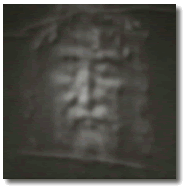
The Gospel evidence
All the four gospels cover vividly the trial, torture, crucifixion, burial and resurrection of Jesus, though some gospels give more details than others. No one else in history passed through all these five phases. In Roman times criminals were hastily sentenced to death by crucifixion. In the case of Jesus the trial was a mockery of justice, and the torture was excessive. Jesus had wounds received by scourging, the crown of thorns, the fall on the way while he was alive, and a spear wound after he was dead. It was his tortured dead body that was placed hastily on the linen cloth (instead of the usual garment) for a quick burial because of the approaching Sabbath. Yet there was time for a quick washing followed by anointing with spices and adorning with some flowers.
The following is a tabulated list of gospel references and comparisons with the Shroud. In Greek of the New Testament the Shroud is 'Sindon' (Italian, 'sindone'). It may be pointed out that the gospel of John mentions smaller pieces of cloth ('Othonia') used as chin bands. There is a facial cloth piece known as the 'Oveido cloth' kept in a cathedral in Oveido, Spain. This cloth does not show any image, but some blood marks are seen. There is evidence that this also came from the Tomb of Jesus. It is most likely the sudarium mentioned in John's gospel (John 20:7).
| 1. Jesus was scourged | Matt. 27:26 (also Mk. & Jn) |
Body covered with severe scourge wounds, as many as 120 on the back (including the legs). Whipping was done probably a Roman flagrum. Evidence for two men whipping from two angles. |
| 2. Jesus was struck a blow to the face | Mt. 27:30 (also Mk, Lk, Jn) |
Severe swelling below the right eye; nose is swollen or broken. |
| 3. Jesus was 'crowned' with thorns | Matt. 27:29 (also Mk, Jn) |
Bleeding from the scalp; thorn fragments. |
| 4. Jesus had to carry a heavy Cross | Jn 19:17 | Shoulder wounds |
| 5. Jesus' Cross had to be carried for him after a while | Mt.27:32 (also Mk, Lk) |
Knees appear to be severely damaged as if from repeated falls. |
| 6. Jesus was crucified by nailing hand and feet | Jn 20:25 | Clear blood flows from nail wounds in the wrists and feet. |
| 7. Jesus' legs were not broken, but a spear was thrust into his side | Jn 19:31-37 | The legs are not broken; there is an elliptical would on the right between the 5th and the 6th side rib and appears to have been inflicted by a Roman lance. |
| 8. Jesus had a Jewish lineage | Matt. 1:16 | Shroud face resembles that of a Sephardic Jew. |
The man of the Shroud was about 6 ft tall; had a beard and moustache. Perhaps parted hair. Middle aged (ca. 30 years old). Eyes appeared to be closed with something round on them.